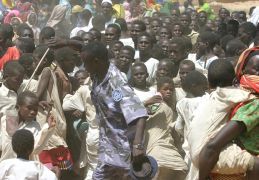Friendly spaces for Darfur displaced children
Mar 6, 2006 (NYALA) — The first time Micha De Winter walked into a child-friendly space in a camp for displaced people in Darfur in March 2005, he found 150 children crowded into 25 square metres, supervised by one animator holding a stick in one hand and a whip in the other.
 “What I found was quite awful. Animators received very little training. There were no materials, and the numbers of children were so huge that hardly anything meaningful could be done in terms of psycho-social support,” De Winter, a child psychologist, said.
“What I found was quite awful. Animators received very little training. There were no materials, and the numbers of children were so huge that hardly anything meaningful could be done in terms of psycho-social support,” De Winter, a child psychologist, said.
The main activities were collective singing and military-like gymnastics. “I thought this had to be an exception,” he said, “but it was the same almost everywhere.”
The objective of the child-friendly spaces was to create a safe environment where children – many of whom had witnessed the burning of their villages and the killing of relatives – could play, express their emotions and regain a sense of normalcy.
However, because the camps for the displaced had grown so quickly – and the need for support was so overwhelming – doubts arose about the quality of these spaces, which are managed by national and international NGOs.
“The needs were enormous, but the staff and funding for these spaces very limited,” said De Winter, who was asked by the United Nations Children’s Fund (UNICEF) to evaluate these services.
In the summer of 2005, the Dutch professor recommended the training of “model animators”, who could pass on their knowledge in child development and community support to others. He also advised that the children be divided into smaller, more manageable groups.
“In large groups, you can’t see whether children are depressed, defensive, withdrawn or aggressive,” he said.
Although the continued expansion of camps had outstripped improvements in many cases, there were significant changes in the way child-friendly spaces were run in some of the camps.
Mustafa Hassan, assistant child protection officer for UNICEF in West Darfur, said that depending on the capacity of the NGO running the space, children were divided into different groups and given specialised activities.
“Smaller groups made possible more diverse activities and allowed for individual attention,” De Winter said. “When this starts to happen, you have real psycho-social support.”
“In West Darfur, 800 teachers were trained in psycho-social support in 2005, emphasising more communication and more attention for traumatised children and children with special needs,” Hassan said.
Despite the improvements, De Winter observed that lack of funding, materials, training and hygiene continued to challenge the programmes.
Child protection
The child-friendly spaces are part of a larger effort by various aid agencies to improve the protection of displaced children, estimated by UNICEF to comprise over 50 percent of most camp populations.
Maha Muna, emergency coordinator of the UN Population Fund (UNFPA) in Sudan, noted that in camps for refugees and displaced people around the world, there were many forms of violence that could be anticipated and prevented.
She noted that when a woman who headed a household had to leave the camp to look for a job, work the land or collect firewood, her children would be left alone.
“The oldest child will be responsible for the rest and will be vulnerable to exploitation,” she said. “And that’s why having opportunities for children to have education is a protection issue, fundamentally.”
De Winter said that in many camps there were not enough schools to educate all the children. Parents often gave priority to their sons, leaving daughters without an education.
Mustafa Hassan noted that the child-friendly spaces could potentially fill some of the gaps. A number of them were already offering literacy classes for girls who had to look after their siblings and could not go to school.
“Last week I saw 25 girls attending literacy classes in a child-friendly space,” he said. “Five of them were carrying a baby.”
Nothing to do
The disintegration of community care and support structures and the absence of numerous activities that would keep children busy in rural settings made displaced children more vulnerable to idleness, aid workers observed.
“Except for the serious protection issues – boys recruited as child soldiers, girls being raped – the main problem for children is the lack of facilities for them in camps while they’re growing up,” De Winter said.
He also identified the “culture of violence” within families, between parents and children, and among children themselves as a serious problem.
“Stopping corporal punishment is a child-protection issue of the first order,” he said. “If you don’t teach your children how to resolve conflict in a peaceful way, they learn that violence is a solution to conflict. This circle of violence will continue when they grow up. It is a crucial element in fostering peace.”
The child psychologist also felt there was too little recognition of the importance of fostering joy and happiness within schools and child-friendly spaces.
“Laughing and being happy is one of the best ways to deal with trauma,” he said. “I would only fund child-friendly spaces that make children laugh at least 10 times a day.”
(IRIN)
